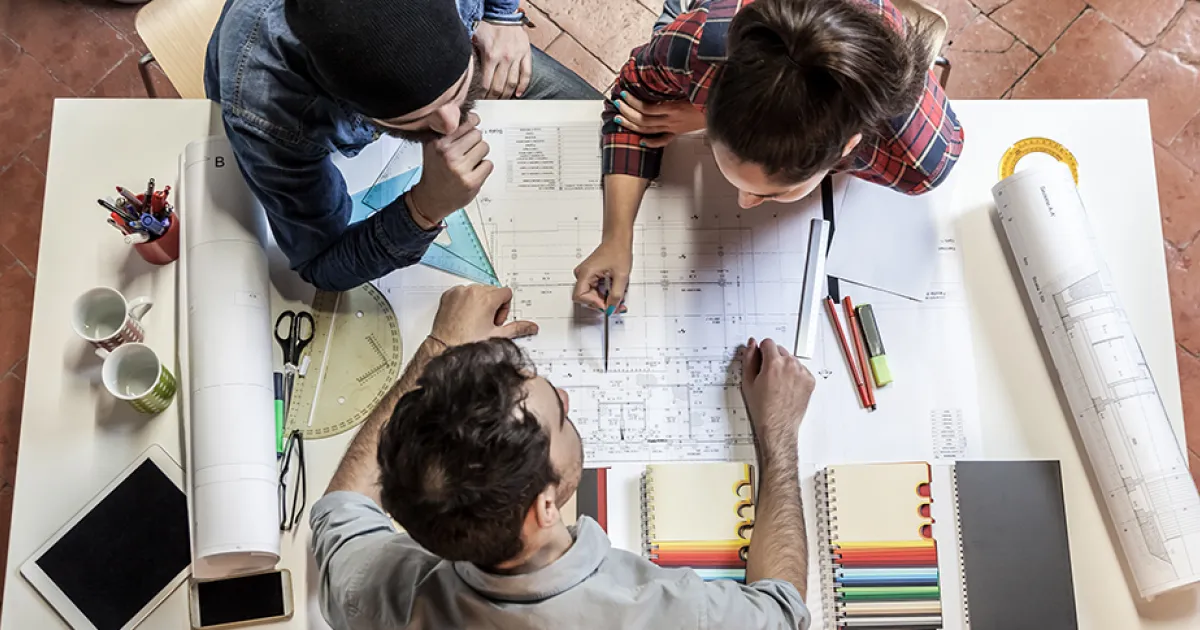Architect Tips for Creating Contemporary Residential Spaces
Architect Tips for Creating Contemporary Residential Spaces
Blog Article
Understanding the Diverse Career Paths Available for Aspiring Architect
As an aspiring Architect, you have a globe of career courses awaiting you. Each course supplies one-of-a-kind challenges and opportunities to apply your creativity and technological expertise. Whether you're attracted to standard design or the nuances of sustainable design, there's a specific niche that lines up with your interests. Understanding these varied alternatives can shape your professional trip, yet which instructions will you choose to explore initially?
Traditional Design: Designing Buildings and Frameworks
Standard architecture focuses on making buildings and frameworks that blend performance with visual appeal. Your styles can mirror social heritage, showcasing local customs while fulfilling contemporary demands.
You'll develop skills in preparing, model-making, and website evaluation, allowing you to imagine and interact your concepts efficiently. Engaging with customers, you'll require to recognize their vision and translate it into possible styles.
Moreover, constructing codes and sustainability techniques are vital in your job, guaranteeing your frameworks are safe and eco-friendly. As you grow in your career, you'll discover possibilities in household, business, and even restoration projects, each offering distinct challenges. Embracing conventional architecture leads the means for a meeting job that admires the past while forming the future.
Urban Preparation: Forming Neighborhoods and Public Spaces
As a hopeful Architect, you can play a vital role as an urban planner, changing exactly how neighborhoods engage and function. By employing area involvement methods, you'll ensure that residents have a voice fit their atmosphere. Plus, incorporating lasting design concepts will help develop areas that not only meet today's needs yet likewise safeguard the future.
Duty of Urban Planners
While numerous may believe of engineers as the single dreamers behind structures, urban planners play a necessary duty in forming the more comprehensive landscape of communities and public spaces. By collaborating with various stakeholders, you'll help develop parks, transportation systems, and domestic areas that promote social interaction and availability. Your expertise in spatial design and community dynamics enables you to imagine future growth while protecting cultural heritage.
Community Engagement Strategies
Reliable community interaction approaches are important for metropolitan organizers to guarantee that the voices of citizens are listened to and valued in the planning process. To promote significant dialogue, you should prioritize open discussion forums and workshops where community participants can express their ideas and worries. By proactively integrating and paying attention responses, you'll develop rooms that reflect the community's needs, eventually leading to more successful and sustainable metropolitan atmospheres.
Lasting Layout Concepts
When creating metropolitan areas, including sustainable layout principles is important for producing atmospheres that flourish both ecologically and socially. You ought to start by focusing on power performance, making use of products that reduce waste and advertise recycling. Take into consideration integrating eco-friendly spaces, like gardens and parks, to boost biodiversity and boost air high quality. Promoting walkability and public transport can minimize dependence on cars, fostering a much healthier area.
Designing with water preservation in mind is likewise vital-- consider rainfall gardens and absorptive surfaces to handle stormwater. Involving area members throughout the preparation process warranties that the areas you develop satisfy their demands and motivate social communication. By embracing these concepts, you'll contribute to dynamic, lasting urban landscapes that profit everyone.

Landscape Design: Producing Sustainable Exterior Atmospheres
As you check out landscape architecture, you'll find vital layout principles that create useful and gorgeous outside rooms. Lasting techniques play an important role in making sure these settings grow while minimizing environmental effect. Plus, you'll discover a range of job opportunities that allow you to make a real difference in how people communicate with nature.
Design Principles in Landscape
Understanding design principles in landscape style is essential for developing lasting exterior settings that balance with nature. You'll require to consider elements like percentage, range, and balance to guarantee your designs really feel natural and welcoming. Integrating native plants not only enhances biodiversity yet also decreases water usage, making your landscape durable. Consider the flow of space and just how people engage with it; pathways and seating locations must invite expedition and relaxation. In addition, focus on seasonal changes, designing with products that complement the environments year-round (Architect). By prioritizing sustainability and visual appeals, you can create outside spaces that enhance the community and advertise well-being. Accepting these concepts will establish a strong structure for your profession in landscape style.
Lasting Practices Review
Lasting practices in landscape design not just concentrate on aesthetic appeals but likewise prioritize ecological health and wellness and resource conservation. By incorporating indigenous plants, you boost biodiversity and reduce the need for chemical fertilizers and pesticides. Carrying out effective watering systems assists save water and lessens drainage, shielding neighboring ecosystems. You can design spaces that advertise dirt wellness, such as making use of organic materials and practicing permaculture principles. Furthermore, incorporating eco-friendly facilities, like rain gardens and permeable pavements, aids in stormwater administration and decreases urban heat. When you develop exterior atmospheres with sustainability in mind, you add to a healthier earth and supply areas that foster area link. Ultimately, these techniques ensure your layouts profit both people and the environment for many years to find.
Job Opportunities Exploration
With a solid structure in sustainable practices, landscape architecture provides a variety of profession paths that permit you to make a meaningful influence on the setting. Urban planners typically work together with landscape architects to create environment-friendly rooms in metropolitan settings, boosting city livability. If you're enthusiastic regarding education, take into consideration coming to be a landscape design educator, motivating future generations.
Lasting Design: Concentrating on Eco-Friendly Practices
As you discover your profession in style, welcoming eco-friendly techniques can set you apart in a competitive area. Sustainable layout concentrates on developing buildings that minimize ecological impact while boosting resident health. By integrating renewable products, energy-efficient systems, and sustainable structure techniques, you'll add to a greener future.
Begin by gaining expertise of eco-friendly accreditations like LEED or BREEAM, which can strengthen your qualifications. Consider just how natural light, air flow, and thermal effectiveness can optimize style. Collaborate with designers and ecological specialists to introduce services that lower waste and conserve sources.
Do not fail to remember the importance of neighborhood participation-- engaging regional stakeholders can influence layouts that harmonize with the atmosphere. As customers significantly prioritize sustainability, your expertise in environment-friendly practices will not only draw in jobs yet additionally fulfill your passion for responsible design. Welcome this important facet of the career, and watch your profession thrive.
Historical Conservation: Protecting and Restoring Cultural Heritage
While you begin on your architectural journey, think about the essential role of historic preservation in maintaining our cultural heritage. This area concentrates on the defense and reconstruction of significant structures, websites, and frameworks that inform the stories of our past. By engaging in historic conservation, you'll aid secure the architectural legacy that shapes area identification.
As a historical preservation Architect, you'll examine historical value and evaluate the problem of structures. You'll function very closely with preservationists and historians to assure authentic reconstruction techniques are used. This career course permits you to blend imagination with research study, enabling you to design services that value original materials and workmanship.
Your work not just contributes to sustainability by reusing existing structures yet also cultivates a feeling of satisfaction within neighborhoods. Welcoming this path will aid you end up being a guardian of history, preserving the stories and appearances that improve our lives.
Inside Style: Enhancing Indoor Spaces
Historical conservation and indoor design both share a commitment to improving the developed setting, but they focus on different elements. While historic conservation stresses preserving a framework's social and historic worth, indoor design absolutely nos in on enhancing interior rooms for capability and appearances.
As a hopeful Architect, you'll find that indoor architecture permits you to go to this site mix imagination with technological abilities. You'll develop areas that not only look good yet likewise advertise convenience and efficiency. This field includes recognizing just how light, color, and products communicate within an area, affecting mood and important site use.
You'll deal with various jobs, from household homes to commercial workplaces, guaranteeing that each environment meets the demands of its occupants. By focusing on user experience, you can transform insides into functional and motivating areas, making a substantial effect on just how individuals communicate with their surroundings. Embrace the possibility to improve interior environments and form the means individuals work and live.
Industrial Design: Combining Capability With Aesthetics
Industrial layout plays a vital function in producing items that perfectly mix visual appeals with functionality, ensuring that what you make use of day-to-day is not only visually enticing but also practical. As a hopeful Architect, you might immerse yourself in this field, concentrating on creating whatever from furnishings to consumer electronics. Your job includes recognizing user needs, products, and making processes, allowing you to produce ingenious options that boost everyday experiences.
In commercial layout, you'll commonly work together with designers, makers, and marketers, ensuring that your designs are not just attractive yet likewise viable. This profession path provides a dynamic atmosphere where creative thinking fulfills practicality, making it a rewarding selection for engineers interested in forming the products of tomorrow.
Frequently Asked Questions
What Educational Qualifications Do I Need to End Up Being an Architect?
To come to be an engineer, you'll need a specialist degree in style, typically a Bachelor's or Master's. In addition, you'll need to complete a teaching fellowship and pass the Architect Enrollment Assessment to practice legitimately.
Are There Accreditation Demands for Various Architectural Career Paths?
Yes, there're qualification demands for different architectural courses. Architect. You'll require to pass examinations, complete internships, and sometimes seek specialized training, relying on your selected emphasis, like landscape design, city style, or historic preservation
What Software Program Skills Are Crucial for Designers Today?

Just How Can I Gain Practical Experience While Examining Style?
You can obtain practical experience by interning at building companies, taking part in design competitions, volunteering for area jobs, or collaborating with classmates on real-world assignments. These chances enhance your skills and construct important connections in the market.
What Job Opportunities Exist Outside Traditional Design Firms?
You can discover numerous work possibilities outside standard design firms, like city preparation, interior decoration, landscape style, building and construction monitoring, realty advancement, and even roles in sustainability consulting. Each deals special difficulties and rewards.
Whether you're drawn to standard style or the nuances of sustainable style, there's a particular niche that lines up with your interests.When designing urban areas, incorporating lasting layout like it concepts is critical for creating atmospheres that prosper both environmentally and socially.As you discover landscape architecture, you'll discover vital design principles that produce attractive and useful exterior areas.Comprehending style concepts in landscape architecture is essential for producing lasting outdoor settings that integrate with nature.In industrial layout, you'll commonly team up with makers, marketing professionals, and engineers, making sure that your layouts are not only attractive however likewise possible.
Report this page